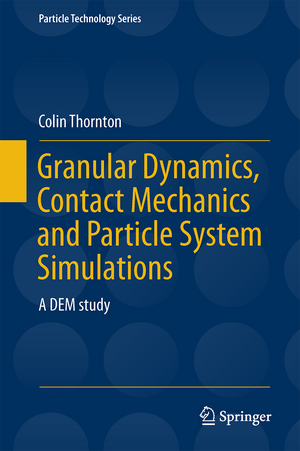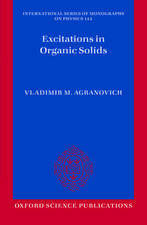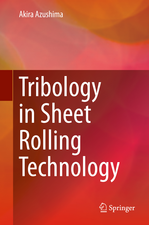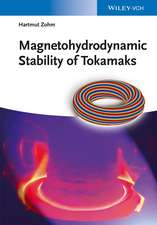Granular Dynamics, Contact Mechanics and Particle System Simulations: A DEM study: Particle Technology Series, cartea 24
Autor Colin Thorntonen Limba Engleză Hardback – 15 sep 2015
The book provides an extensive and detailed explanation of the theoretical background of DEM. Contact mechanics theories for elastic, elastic-plastic, adhesive elastic and adhesive elastic-plastic particle-particle interactions are presented. Other contact force models are also discussed, including corrections to some of these models as described in the literature, and important areas of further research are identified.
A key issue in DEM simulations is whether or not a code can reliably simulate the simplest of systems, namely the single particle oblique impact with a wall. This is discussed using the output obtained from the contact force models described earlier, which are compared for elastic and inelastic collisions. In addition, further insight is provided for the impact of adhesive particles. The author then moves on to provide the results of selected DEM applications to agglomerate impacts, fluidised beds and quasi-static deformation, demonstrating that the DEM technique can be used (i) to mimic experiments, (ii) explore parameter sweeps, including limiting values, or (iii) identify new, previously unknown, phenomena at the microscale.
In the DEM applications the emphasis is on discovering new information that enhances our rational understanding of particle systems, which may be more significant than developing a new continuum model that encompasses all microstructural aspects, which would most likely prove too complicated for practical implementation. The book will be of interestto academic and industrial researchers working in particle technology/process engineering and geomechanics, both experimentalists and theoreticians.
| Toate formatele și edițiile | Preț | Express |
|---|---|---|
| Paperback (1) | 472.77 lei 38-44 zile | |
| Springer International Publishing – 22 oct 2016 | 472.77 lei 38-44 zile | |
| Hardback (1) | 735.53 lei 22-36 zile | |
| Springer International Publishing – 15 sep 2015 | 735.53 lei 22-36 zile |
Din seria Particle Technology Series
- 15%
 Preț: 669.66 lei
Preț: 669.66 lei -
 Preț: 383.50 lei
Preț: 383.50 lei - 18%
 Preț: 1545.88 lei
Preț: 1545.88 lei - 15%
 Preț: 642.51 lei
Preț: 642.51 lei - 18%
 Preț: 998.97 lei
Preț: 998.97 lei - 18%
 Preț: 1386.48 lei
Preț: 1386.48 lei - 18%
 Preț: 947.50 lei
Preț: 947.50 lei - 18%
 Preț: 1386.92 lei
Preț: 1386.92 lei - 18%
 Preț: 1389.62 lei
Preț: 1389.62 lei - 18%
 Preț: 1561.68 lei
Preț: 1561.68 lei - 15%
 Preț: 641.71 lei
Preț: 641.71 lei - 15%
 Preț: 663.79 lei
Preț: 663.79 lei - 18%
 Preț: 942.94 lei
Preț: 942.94 lei - 18%
 Preț: 953.82 lei
Preț: 953.82 lei - 24%
 Preț: 793.36 lei
Preț: 793.36 lei - 18%
 Preț: 1114.02 lei
Preț: 1114.02 lei - 18%
 Preț: 888.80 lei
Preț: 888.80 lei - 18%
 Preț: 1224.68 lei
Preț: 1224.68 lei - 18%
 Preț: 1823.07 lei
Preț: 1823.07 lei - 18%
 Preț: 1226.60 lei
Preț: 1226.60 lei - 18%
 Preț: 2094.10 lei
Preț: 2094.10 lei - 18%
 Preț: 1234.46 lei
Preț: 1234.46 lei - 18%
 Preț: 1394.52 lei
Preț: 1394.52 lei - 18%
 Preț: 1226.24 lei
Preț: 1226.24 lei
Preț: 735.53 lei
Preț vechi: 896.98 lei
-18% Nou
Puncte Express: 1103
Preț estimativ în valută:
140.75€ • 147.32$ • 117.14£
140.75€ • 147.32$ • 117.14£
Carte disponibilă
Livrare economică 10-24 martie
Preluare comenzi: 021 569.72.76
Specificații
ISBN-13: 9783319187105
ISBN-10: 3319187104
Pagini: 195
Ilustrații: XIII, 195 p. 144 illus., 13 illus. in color.
Dimensiuni: 155 x 235 x 17 mm
Greutate: 0.67 kg
Ediția:1st ed. 2015
Editura: Springer International Publishing
Colecția Springer
Seria Particle Technology Series
Locul publicării:Cham, Switzerland
ISBN-10: 3319187104
Pagini: 195
Ilustrații: XIII, 195 p. 144 illus., 13 illus. in color.
Dimensiuni: 155 x 235 x 17 mm
Greutate: 0.67 kg
Ediția:1st ed. 2015
Editura: Springer International Publishing
Colecția Springer
Seria Particle Technology Series
Locul publicării:Cham, Switzerland
Public țintă
ResearchCuprins
Foreword.- Preface.- Introduction.- Theoretical Background.- Contact Mechanics.- Other Contact Force Models.- Particle Impact.- Agglomerate Impacts.- Fluidised Beds.- Quasi-Static Deformation.- Index.
Notă biografică
Dr. Colin Thornton, School of Chemical Engineering, University of Birmingham, UK, has published over 100 papers and has an h factor of 30. His main area of expertise is powder technology and in particular he is one of the pioneers of the “discrete element method” (DEM), having made enormous contributions to the application of DEM to theoretical soil mechanics and problems in particulate technology during the last 30 years. Supported by British research council grants and 11 industrial contracts he has developed leading DEM software for the simulation of a variety of systems, which proved outstandingly versatile and is now widely employed for modeling of particulate systems across disciplines.
Textul de pe ultima copertă
This book is devoted to the Discrete Element Method (DEM) technique, a discontinuum modelling approach that takes into account the fact that granular materials are composed of discrete particles which interact with each other at the microscale level. This numerical simulation technique can be used both for dispersed systems in which the particle-particle interactions are collisional and compact systems of particles with multiple enduring contacts.
The book provides an extensive and detailed explanation of the theoretical background of DEM. Contact mechanics theories for elastic, elastic-plastic, adhesive elastic and adhesive elastic-plastic particle-particle interactions are presented. Other contact force models are also discussed, including corrections to some of these models as described in the literature, and important areas of further research are identified.
A key issue in DEM simulations is whether or not a code can reliably simulate the simplest of systems, namely the single particle oblique impact with a wall. This is discussed using the output obtained from the contact force models described earlier, which are compared for elastic and inelastic collisions. In addition, further insight is provided for the impact of adhesive particles. The author then moves on to provide the results of selected DEM applications to agglomerate impacts, fluidised beds and quasi-static deformation, demonstrating that the DEM technique can be used (i) to mimic experiments, (ii) explore parameter sweeps, including limiting values, or (iii) identify new, previously unknown, phenomena at the microscale.
In the DEM applications the emphasis is on discovering new information that enhances our rational understanding of particle systems, which may be more significant than developing a new continuum model that encompasses all microstructural aspects, which would most likely prove too complicated for practical implementation. The book will be of interestto academic and industrial researchers working in particle technology/process engineering and geomechanics, both experimentalists and theoreticians.
The book provides an extensive and detailed explanation of the theoretical background of DEM. Contact mechanics theories for elastic, elastic-plastic, adhesive elastic and adhesive elastic-plastic particle-particle interactions are presented. Other contact force models are also discussed, including corrections to some of these models as described in the literature, and important areas of further research are identified.
A key issue in DEM simulations is whether or not a code can reliably simulate the simplest of systems, namely the single particle oblique impact with a wall. This is discussed using the output obtained from the contact force models described earlier, which are compared for elastic and inelastic collisions. In addition, further insight is provided for the impact of adhesive particles. The author then moves on to provide the results of selected DEM applications to agglomerate impacts, fluidised beds and quasi-static deformation, demonstrating that the DEM technique can be used (i) to mimic experiments, (ii) explore parameter sweeps, including limiting values, or (iii) identify new, previously unknown, phenomena at the microscale.
In the DEM applications the emphasis is on discovering new information that enhances our rational understanding of particle systems, which may be more significant than developing a new continuum model that encompasses all microstructural aspects, which would most likely prove too complicated for practical implementation. The book will be of interestto academic and industrial researchers working in particle technology/process engineering and geomechanics, both experimentalists and theoreticians.
Caracteristici
Written by an absolute pioneer of the discrete element method (DEM) Provides both the fundamentals and a number of practical examples of the applications of the DEM technique Covers the theoretical background of DEM in detail With a Foreword by Jonathan Seville











